British Petroleum (BP) Business Strategy and Analysis Report
VerifiedAdded on 2020/12/29
|12
|3539
|210
Report
AI Summary
This report provides a comprehensive analysis of British Petroleum's (BP) business strategy. It begins with an introduction to business strategy and applies relevant frameworks to assess the impact of the macro environment on BP's strategic policies. The report then utilizes McKinsey's 7S model to evaluate BP's strategic capabilities and internal environment, followed by the application of the VRIO model. Furthermore, Porter's Five Forces analysis is conducted to assess the competitive landscape. Strategic planning techniques, including SWOT analysis, are also explored. The report delves into BP's internal environment, including its structure, systems, style, staff, and skills, before evaluating the competitive forces affecting the organization. The analysis covers threats of substitutes, buyer and supplier bargaining power, and the intensity of rivalry. The report concludes with an overview of the strategic planning processes and their implications for BP's performance.

Business Strategy
Paraphrase This Document
Need a fresh take? Get an instant paraphrase of this document with our AI Paraphraser

INTRODUCTION...........................................................................................................................1
TASK 1............................................................................................................................................1
P1 Applying appropriate frameworks impact and influence of macro environment and its
strategy.........................................................................................................................................1
TASK 2............................................................................................................................................3
P2 Internal environment and capabilities of an organisation......................................................3
TASK 3............................................................................................................................................5
P3 Evaluating competitive forces of an organisation..................................................................5
TASK 4............................................................................................................................................7
P4 Applying theories and models to devise strategic planning for an organisation....................7
CONCLUSION................................................................................................................................8
REFRENCES...................................................................................................................................9
.......................................................................................................................................................10
TASK 1............................................................................................................................................1
P1 Applying appropriate frameworks impact and influence of macro environment and its
strategy.........................................................................................................................................1
TASK 2............................................................................................................................................3
P2 Internal environment and capabilities of an organisation......................................................3
TASK 3............................................................................................................................................5
P3 Evaluating competitive forces of an organisation..................................................................5
TASK 4............................................................................................................................................7
P4 Applying theories and models to devise strategic planning for an organisation....................7
CONCLUSION................................................................................................................................8
REFRENCES...................................................................................................................................9
.......................................................................................................................................................10
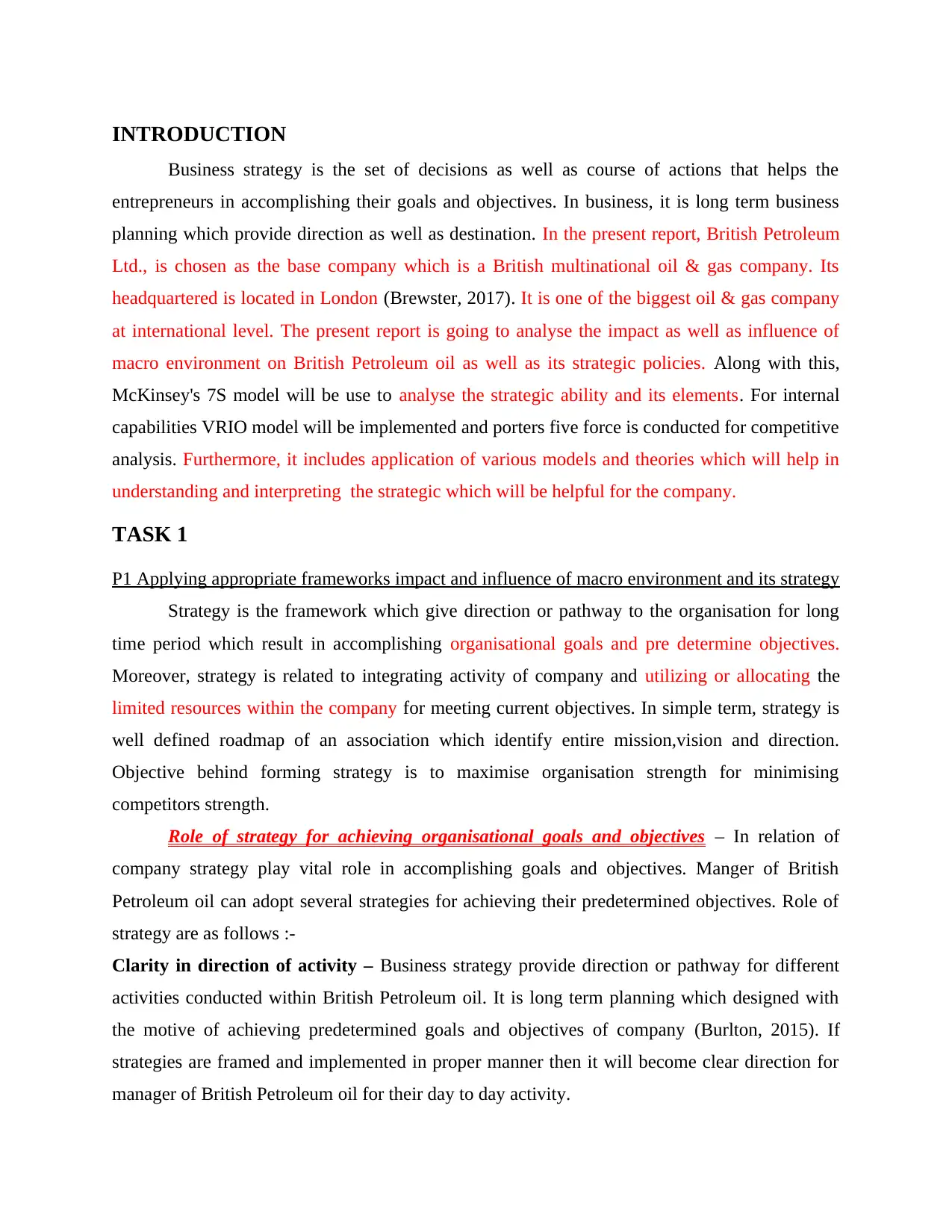
INTRODUCTION
Business strategy is the set of decisions as well as course of actions that helps the
entrepreneurs in accomplishing their goals and objectives. In business, it is long term business
planning which provide direction as well as destination. In the present report, British Petroleum
Ltd., is chosen as the base company which is a British multinational oil & gas company. Its
headquartered is located in London (Brewster, 2017). It is one of the biggest oil & gas company
at international level. The present report is going to analyse the impact as well as influence of
macro environment on British Petroleum oil as well as its strategic policies. Along with this,
McKinsey's 7S model will be use to analyse the strategic ability and its elements. For internal
capabilities VRIO model will be implemented and porters five force is conducted for competitive
analysis. Furthermore, it includes application of various models and theories which will help in
understanding and interpreting the strategic which will be helpful for the company.
TASK 1
P1 Applying appropriate frameworks impact and influence of macro environment and its strategy
Strategy is the framework which give direction or pathway to the organisation for long
time period which result in accomplishing organisational goals and pre determine objectives.
Moreover, strategy is related to integrating activity of company and utilizing or allocating the
limited resources within the company for meeting current objectives. In simple term, strategy is
well defined roadmap of an association which identify entire mission,vision and direction.
Objective behind forming strategy is to maximise organisation strength for minimising
competitors strength.
Role of strategy for achieving organisational goals and objectives – In relation of
company strategy play vital role in accomplishing goals and objectives. Manger of British
Petroleum oil can adopt several strategies for achieving their predetermined objectives. Role of
strategy are as follows :-
Clarity in direction of activity – Business strategy provide direction or pathway for different
activities conducted within British Petroleum oil. It is long term planning which designed with
the motive of achieving predetermined goals and objectives of company (Burlton, 2015). If
strategies are framed and implemented in proper manner then it will become clear direction for
manager of British Petroleum oil for their day to day activity.
Business strategy is the set of decisions as well as course of actions that helps the
entrepreneurs in accomplishing their goals and objectives. In business, it is long term business
planning which provide direction as well as destination. In the present report, British Petroleum
Ltd., is chosen as the base company which is a British multinational oil & gas company. Its
headquartered is located in London (Brewster, 2017). It is one of the biggest oil & gas company
at international level. The present report is going to analyse the impact as well as influence of
macro environment on British Petroleum oil as well as its strategic policies. Along with this,
McKinsey's 7S model will be use to analyse the strategic ability and its elements. For internal
capabilities VRIO model will be implemented and porters five force is conducted for competitive
analysis. Furthermore, it includes application of various models and theories which will help in
understanding and interpreting the strategic which will be helpful for the company.
TASK 1
P1 Applying appropriate frameworks impact and influence of macro environment and its strategy
Strategy is the framework which give direction or pathway to the organisation for long
time period which result in accomplishing organisational goals and pre determine objectives.
Moreover, strategy is related to integrating activity of company and utilizing or allocating the
limited resources within the company for meeting current objectives. In simple term, strategy is
well defined roadmap of an association which identify entire mission,vision and direction.
Objective behind forming strategy is to maximise organisation strength for minimising
competitors strength.
Role of strategy for achieving organisational goals and objectives – In relation of
company strategy play vital role in accomplishing goals and objectives. Manger of British
Petroleum oil can adopt several strategies for achieving their predetermined objectives. Role of
strategy are as follows :-
Clarity in direction of activity – Business strategy provide direction or pathway for different
activities conducted within British Petroleum oil. It is long term planning which designed with
the motive of achieving predetermined goals and objectives of company (Burlton, 2015). If
strategies are framed and implemented in proper manner then it will become clear direction for
manager of British Petroleum oil for their day to day activity.
⊘ This is a preview!⊘
Do you want full access?
Subscribe today to unlock all pages.

Trusted by 1+ million students worldwide
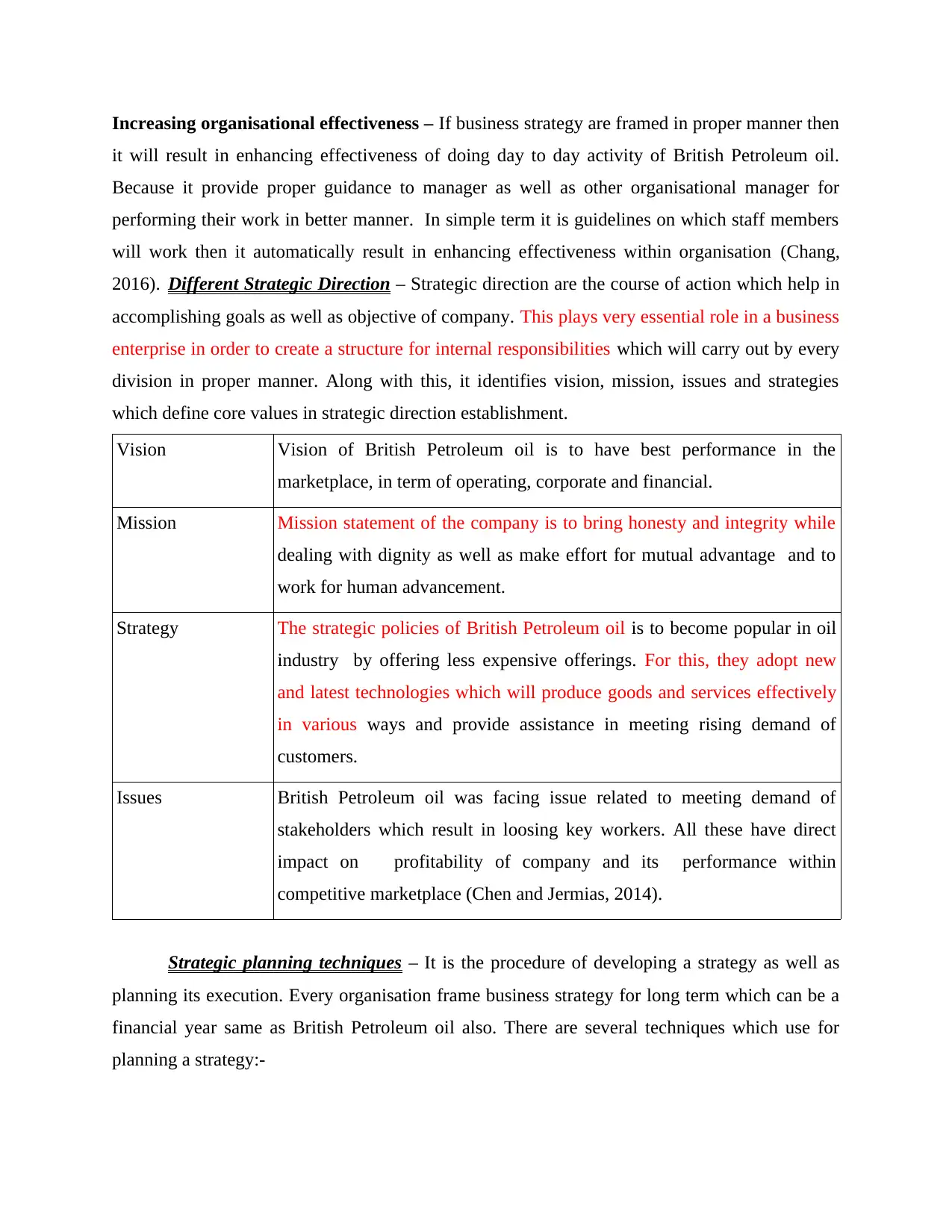
Increasing organisational effectiveness – If business strategy are framed in proper manner then
it will result in enhancing effectiveness of doing day to day activity of British Petroleum oil.
Because it provide proper guidance to manager as well as other organisational manager for
performing their work in better manner. In simple term it is guidelines on which staff members
will work then it automatically result in enhancing effectiveness within organisation (Chang,
2016). Different Strategic Direction – Strategic direction are the course of action which help in
accomplishing goals as well as objective of company. This plays very essential role in a business
enterprise in order to create a structure for internal responsibilities which will carry out by every
division in proper manner. Along with this, it identifies vision, mission, issues and strategies
which define core values in strategic direction establishment.
Vision Vision of British Petroleum oil is to have best performance in the
marketplace, in term of operating, corporate and financial.
Mission Mission statement of the company is to bring honesty and integrity while
dealing with dignity as well as make effort for mutual advantage and to
work for human advancement.
Strategy The strategic policies of British Petroleum oil is to become popular in oil
industry by offering less expensive offerings. For this, they adopt new
and latest technologies which will produce goods and services effectively
in various ways and provide assistance in meeting rising demand of
customers.
Issues British Petroleum oil was facing issue related to meeting demand of
stakeholders which result in loosing key workers. All these have direct
impact on profitability of company and its performance within
competitive marketplace (Chen and Jermias, 2014).
Strategic planning techniques – It is the procedure of developing a strategy as well as
planning its execution. Every organisation frame business strategy for long term which can be a
financial year same as British Petroleum oil also. There are several techniques which use for
planning a strategy:-
it will result in enhancing effectiveness of doing day to day activity of British Petroleum oil.
Because it provide proper guidance to manager as well as other organisational manager for
performing their work in better manner. In simple term it is guidelines on which staff members
will work then it automatically result in enhancing effectiveness within organisation (Chang,
2016). Different Strategic Direction – Strategic direction are the course of action which help in
accomplishing goals as well as objective of company. This plays very essential role in a business
enterprise in order to create a structure for internal responsibilities which will carry out by every
division in proper manner. Along with this, it identifies vision, mission, issues and strategies
which define core values in strategic direction establishment.
Vision Vision of British Petroleum oil is to have best performance in the
marketplace, in term of operating, corporate and financial.
Mission Mission statement of the company is to bring honesty and integrity while
dealing with dignity as well as make effort for mutual advantage and to
work for human advancement.
Strategy The strategic policies of British Petroleum oil is to become popular in oil
industry by offering less expensive offerings. For this, they adopt new
and latest technologies which will produce goods and services effectively
in various ways and provide assistance in meeting rising demand of
customers.
Issues British Petroleum oil was facing issue related to meeting demand of
stakeholders which result in loosing key workers. All these have direct
impact on profitability of company and its performance within
competitive marketplace (Chen and Jermias, 2014).
Strategic planning techniques – It is the procedure of developing a strategy as well as
planning its execution. Every organisation frame business strategy for long term which can be a
financial year same as British Petroleum oil also. There are several techniques which use for
planning a strategy:-
Paraphrase This Document
Need a fresh take? Get an instant paraphrase of this document with our AI Paraphraser
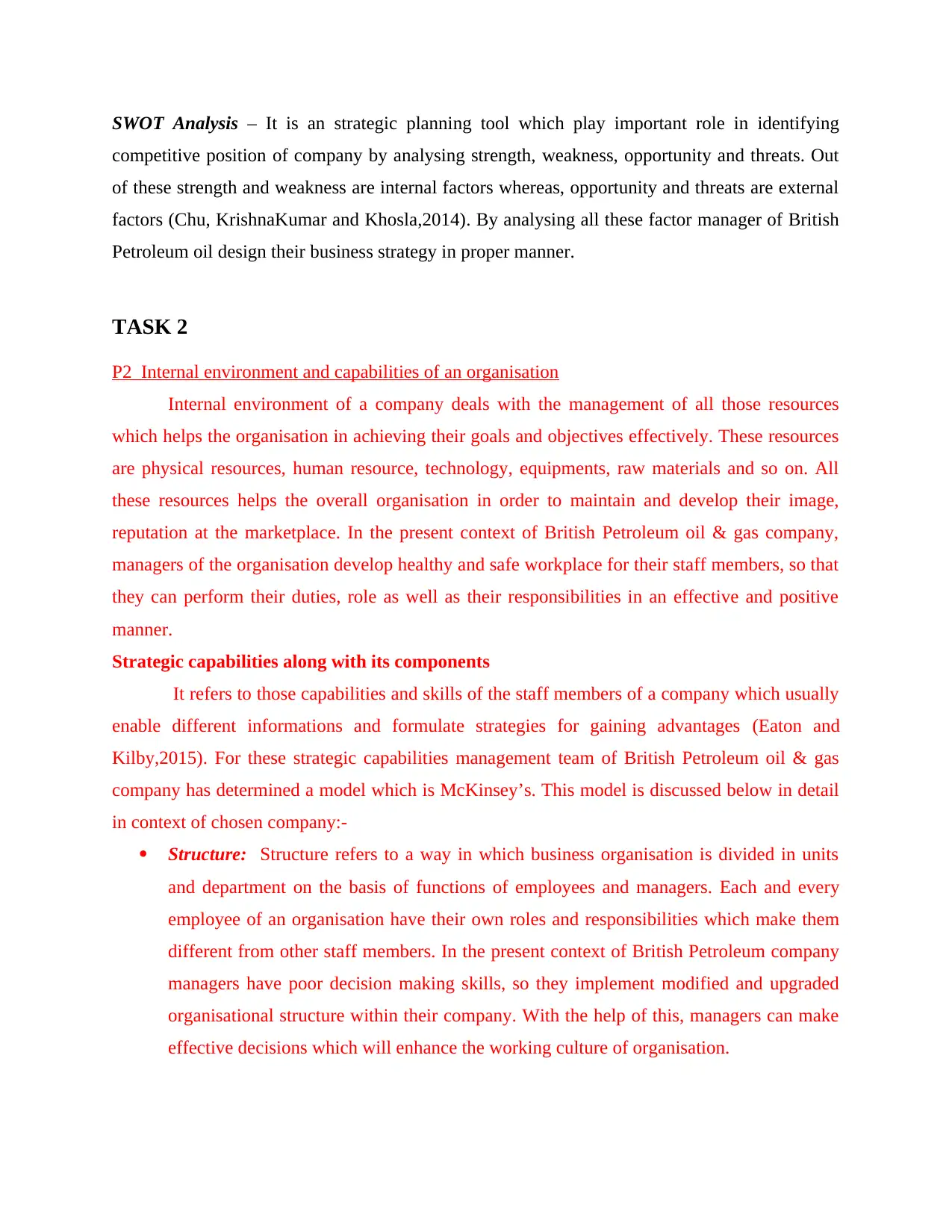
SWOT Analysis – It is an strategic planning tool which play important role in identifying
competitive position of company by analysing strength, weakness, opportunity and threats. Out
of these strength and weakness are internal factors whereas, opportunity and threats are external
factors (Chu, KrishnaKumar and Khosla,2014). By analysing all these factor manager of British
Petroleum oil design their business strategy in proper manner.
TASK 2
P2 Internal environment and capabilities of an organisation
Internal environment of a company deals with the management of all those resources
which helps the organisation in achieving their goals and objectives effectively. These resources
are physical resources, human resource, technology, equipments, raw materials and so on. All
these resources helps the overall organisation in order to maintain and develop their image,
reputation at the marketplace. In the present context of British Petroleum oil & gas company,
managers of the organisation develop healthy and safe workplace for their staff members, so that
they can perform their duties, role as well as their responsibilities in an effective and positive
manner.
Strategic capabilities along with its components
It refers to those capabilities and skills of the staff members of a company which usually
enable different informations and formulate strategies for gaining advantages (Eaton and
Kilby,2015). For these strategic capabilities management team of British Petroleum oil & gas
company has determined a model which is McKinsey’s. This model is discussed below in detail
in context of chosen company:-
Structure: Structure refers to a way in which business organisation is divided in units
and department on the basis of functions of employees and managers. Each and every
employee of an organisation have their own roles and responsibilities which make them
different from other staff members. In the present context of British Petroleum company
managers have poor decision making skills, so they implement modified and upgraded
organisational structure within their company. With the help of this, managers can make
effective decisions which will enhance the working culture of organisation.
competitive position of company by analysing strength, weakness, opportunity and threats. Out
of these strength and weakness are internal factors whereas, opportunity and threats are external
factors (Chu, KrishnaKumar and Khosla,2014). By analysing all these factor manager of British
Petroleum oil design their business strategy in proper manner.
TASK 2
P2 Internal environment and capabilities of an organisation
Internal environment of a company deals with the management of all those resources
which helps the organisation in achieving their goals and objectives effectively. These resources
are physical resources, human resource, technology, equipments, raw materials and so on. All
these resources helps the overall organisation in order to maintain and develop their image,
reputation at the marketplace. In the present context of British Petroleum oil & gas company,
managers of the organisation develop healthy and safe workplace for their staff members, so that
they can perform their duties, role as well as their responsibilities in an effective and positive
manner.
Strategic capabilities along with its components
It refers to those capabilities and skills of the staff members of a company which usually
enable different informations and formulate strategies for gaining advantages (Eaton and
Kilby,2015). For these strategic capabilities management team of British Petroleum oil & gas
company has determined a model which is McKinsey’s. This model is discussed below in detail
in context of chosen company:-
Structure: Structure refers to a way in which business organisation is divided in units
and department on the basis of functions of employees and managers. Each and every
employee of an organisation have their own roles and responsibilities which make them
different from other staff members. In the present context of British Petroleum company
managers have poor decision making skills, so they implement modified and upgraded
organisational structure within their company. With the help of this, managers can make
effective decisions which will enhance the working culture of organisation.
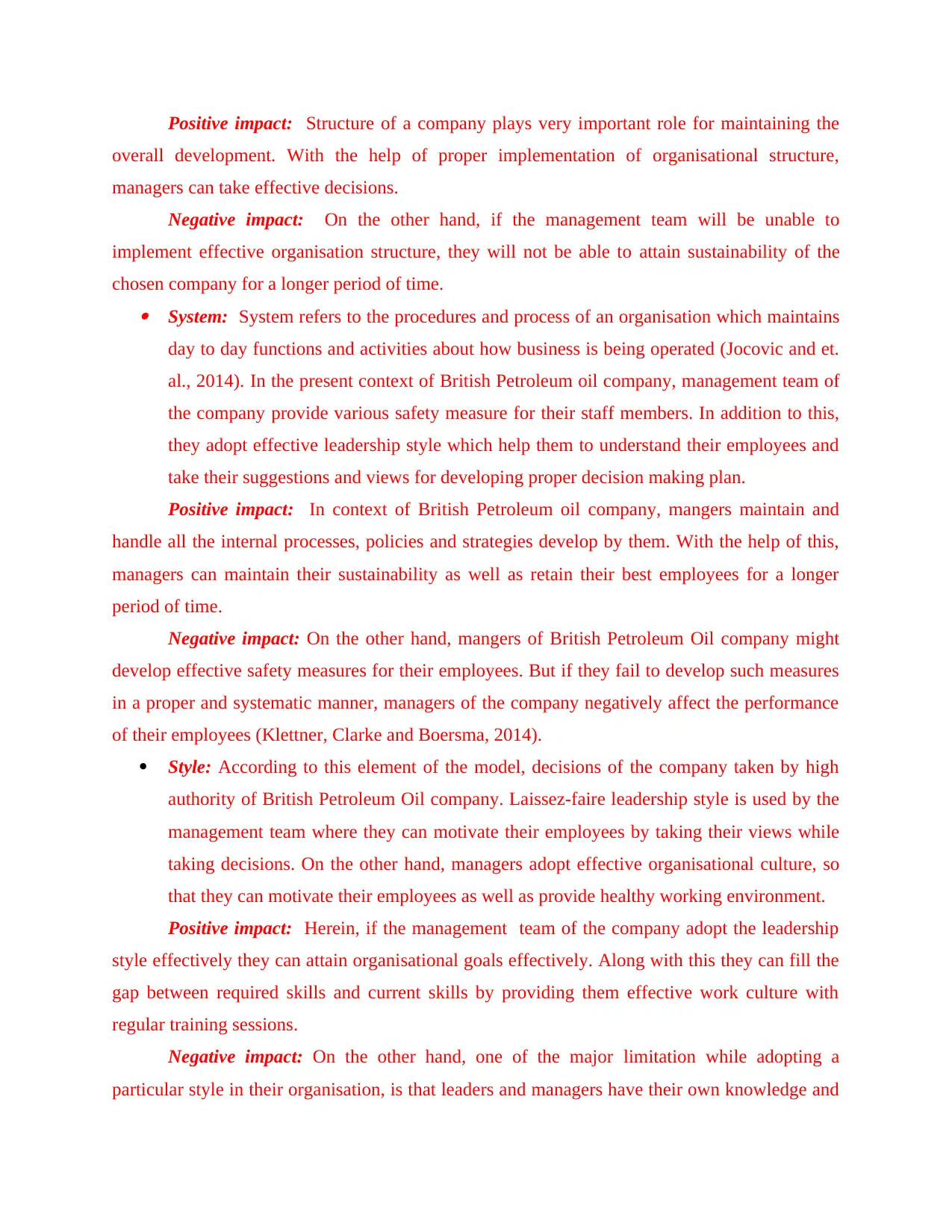
Positive impact: Structure of a company plays very important role for maintaining the
overall development. With the help of proper implementation of organisational structure,
managers can take effective decisions.
Negative impact: On the other hand, if the management team will be unable to
implement effective organisation structure, they will not be able to attain sustainability of the
chosen company for a longer period of time. System: System refers to the procedures and process of an organisation which maintains
day to day functions and activities about how business is being operated (Jocovic and et.
al., 2014). In the present context of British Petroleum oil company, management team of
the company provide various safety measure for their staff members. In addition to this,
they adopt effective leadership style which help them to understand their employees and
take their suggestions and views for developing proper decision making plan.
Positive impact: In context of British Petroleum oil company, mangers maintain and
handle all the internal processes, policies and strategies develop by them. With the help of this,
managers can maintain their sustainability as well as retain their best employees for a longer
period of time.
Negative impact: On the other hand, mangers of British Petroleum Oil company might
develop effective safety measures for their employees. But if they fail to develop such measures
in a proper and systematic manner, managers of the company negatively affect the performance
of their employees (Klettner, Clarke and Boersma, 2014).
Style: According to this element of the model, decisions of the company taken by high
authority of British Petroleum Oil company. Laissez-faire leadership style is used by the
management team where they can motivate their employees by taking their views while
taking decisions. On the other hand, managers adopt effective organisational culture, so
that they can motivate their employees as well as provide healthy working environment.
Positive impact: Herein, if the management team of the company adopt the leadership
style effectively they can attain organisational goals effectively. Along with this they can fill the
gap between required skills and current skills by providing them effective work culture with
regular training sessions.
Negative impact: On the other hand, one of the major limitation while adopting a
particular style in their organisation, is that leaders and managers have their own knowledge and
overall development. With the help of proper implementation of organisational structure,
managers can take effective decisions.
Negative impact: On the other hand, if the management team will be unable to
implement effective organisation structure, they will not be able to attain sustainability of the
chosen company for a longer period of time. System: System refers to the procedures and process of an organisation which maintains
day to day functions and activities about how business is being operated (Jocovic and et.
al., 2014). In the present context of British Petroleum oil company, management team of
the company provide various safety measure for their staff members. In addition to this,
they adopt effective leadership style which help them to understand their employees and
take their suggestions and views for developing proper decision making plan.
Positive impact: In context of British Petroleum oil company, mangers maintain and
handle all the internal processes, policies and strategies develop by them. With the help of this,
managers can maintain their sustainability as well as retain their best employees for a longer
period of time.
Negative impact: On the other hand, mangers of British Petroleum Oil company might
develop effective safety measures for their employees. But if they fail to develop such measures
in a proper and systematic manner, managers of the company negatively affect the performance
of their employees (Klettner, Clarke and Boersma, 2014).
Style: According to this element of the model, decisions of the company taken by high
authority of British Petroleum Oil company. Laissez-faire leadership style is used by the
management team where they can motivate their employees by taking their views while
taking decisions. On the other hand, managers adopt effective organisational culture, so
that they can motivate their employees as well as provide healthy working environment.
Positive impact: Herein, if the management team of the company adopt the leadership
style effectively they can attain organisational goals effectively. Along with this they can fill the
gap between required skills and current skills by providing them effective work culture with
regular training sessions.
Negative impact: On the other hand, one of the major limitation while adopting a
particular style in their organisation, is that leaders and managers have their own knowledge and
⊘ This is a preview!⊘
Do you want full access?
Subscribe today to unlock all pages.

Trusted by 1+ million students worldwide
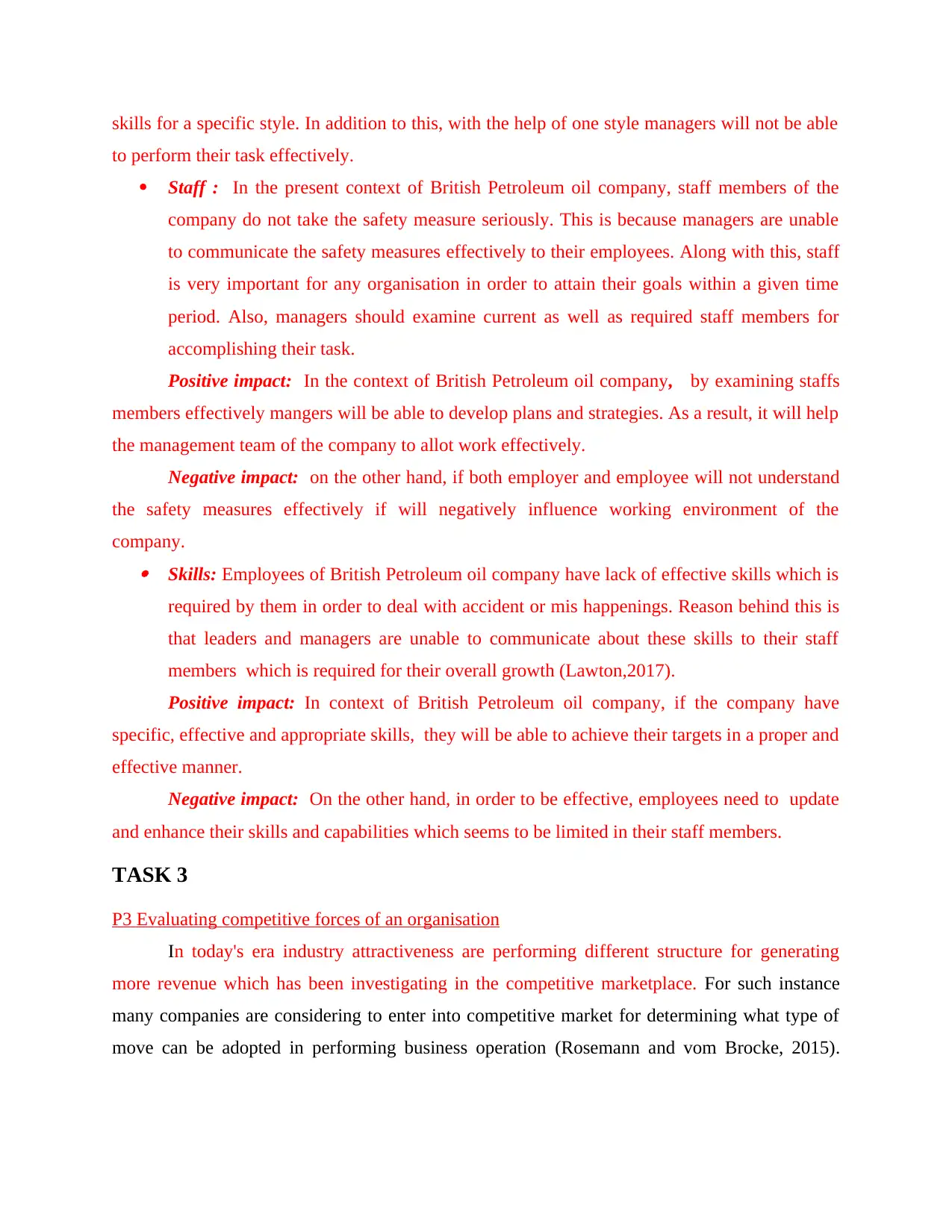
skills for a specific style. In addition to this, with the help of one style managers will not be able
to perform their task effectively.
Staff : In the present context of British Petroleum oil company, staff members of the
company do not take the safety measure seriously. This is because managers are unable
to communicate the safety measures effectively to their employees. Along with this, staff
is very important for any organisation in order to attain their goals within a given time
period. Also, managers should examine current as well as required staff members for
accomplishing their task.
Positive impact: In the context of British Petroleum oil company, by examining staffs
members effectively mangers will be able to develop plans and strategies. As a result, it will help
the management team of the company to allot work effectively.
Negative impact: on the other hand, if both employer and employee will not understand
the safety measures effectively if will negatively influence working environment of the
company. Skills: Employees of British Petroleum oil company have lack of effective skills which is
required by them in order to deal with accident or mis happenings. Reason behind this is
that leaders and managers are unable to communicate about these skills to their staff
members which is required for their overall growth (Lawton,2017).
Positive impact: In context of British Petroleum oil company, if the company have
specific, effective and appropriate skills, they will be able to achieve their targets in a proper and
effective manner.
Negative impact: On the other hand, in order to be effective, employees need to update
and enhance their skills and capabilities which seems to be limited in their staff members.
TASK 3
P3 Evaluating competitive forces of an organisation
In today's era industry attractiveness are performing different structure for generating
more revenue which has been investigating in the competitive marketplace. For such instance
many companies are considering to enter into competitive market for determining what type of
move can be adopted in performing business operation (Rosemann and vom Brocke, 2015).
to perform their task effectively.
Staff : In the present context of British Petroleum oil company, staff members of the
company do not take the safety measure seriously. This is because managers are unable
to communicate the safety measures effectively to their employees. Along with this, staff
is very important for any organisation in order to attain their goals within a given time
period. Also, managers should examine current as well as required staff members for
accomplishing their task.
Positive impact: In the context of British Petroleum oil company, by examining staffs
members effectively mangers will be able to develop plans and strategies. As a result, it will help
the management team of the company to allot work effectively.
Negative impact: on the other hand, if both employer and employee will not understand
the safety measures effectively if will negatively influence working environment of the
company. Skills: Employees of British Petroleum oil company have lack of effective skills which is
required by them in order to deal with accident or mis happenings. Reason behind this is
that leaders and managers are unable to communicate about these skills to their staff
members which is required for their overall growth (Lawton,2017).
Positive impact: In context of British Petroleum oil company, if the company have
specific, effective and appropriate skills, they will be able to achieve their targets in a proper and
effective manner.
Negative impact: On the other hand, in order to be effective, employees need to update
and enhance their skills and capabilities which seems to be limited in their staff members.
TASK 3
P3 Evaluating competitive forces of an organisation
In today's era industry attractiveness are performing different structure for generating
more revenue which has been investigating in the competitive marketplace. For such instance
many companies are considering to enter into competitive market for determining what type of
move can be adopted in performing business operation (Rosemann and vom Brocke, 2015).
Paraphrase This Document
Need a fresh take? Get an instant paraphrase of this document with our AI Paraphraser
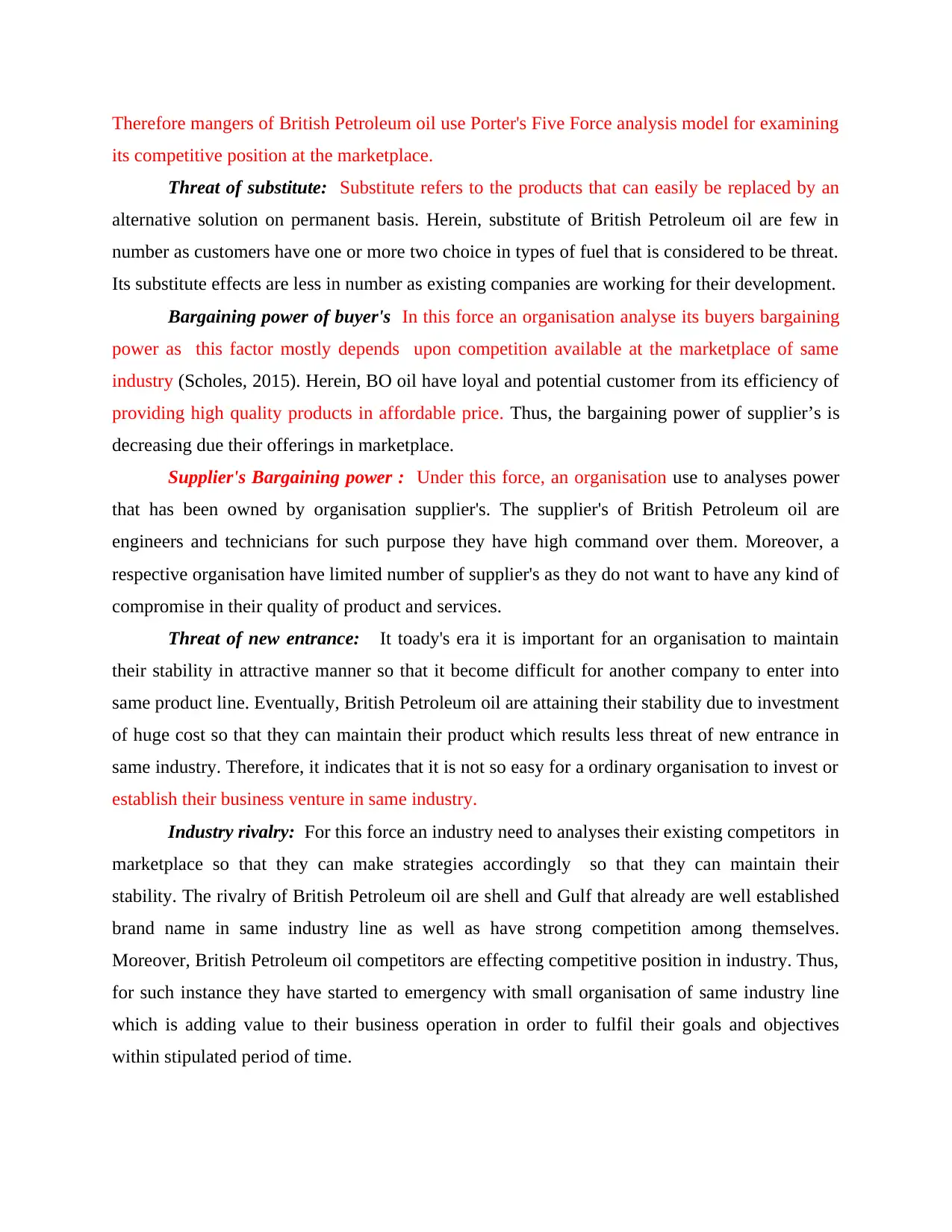
Therefore mangers of British Petroleum oil use Porter's Five Force analysis model for examining
its competitive position at the marketplace.
Threat of substitute: Substitute refers to the products that can easily be replaced by an
alternative solution on permanent basis. Herein, substitute of British Petroleum oil are few in
number as customers have one or more two choice in types of fuel that is considered to be threat.
Its substitute effects are less in number as existing companies are working for their development.
Bargaining power of buyer's In this force an organisation analyse its buyers bargaining
power as this factor mostly depends upon competition available at the marketplace of same
industry (Scholes, 2015). Herein, BO oil have loyal and potential customer from its efficiency of
providing high quality products in affordable price. Thus, the bargaining power of supplier’s is
decreasing due their offerings in marketplace.
Supplier's Bargaining power : Under this force, an organisation use to analyses power
that has been owned by organisation supplier's. The supplier's of British Petroleum oil are
engineers and technicians for such purpose they have high command over them. Moreover, a
respective organisation have limited number of supplier's as they do not want to have any kind of
compromise in their quality of product and services.
Threat of new entrance: It toady's era it is important for an organisation to maintain
their stability in attractive manner so that it become difficult for another company to enter into
same product line. Eventually, British Petroleum oil are attaining their stability due to investment
of huge cost so that they can maintain their product which results less threat of new entrance in
same industry. Therefore, it indicates that it is not so easy for a ordinary organisation to invest or
establish their business venture in same industry.
Industry rivalry: For this force an industry need to analyses their existing competitors in
marketplace so that they can make strategies accordingly so that they can maintain their
stability. The rivalry of British Petroleum oil are shell and Gulf that already are well established
brand name in same industry line as well as have strong competition among themselves.
Moreover, British Petroleum oil competitors are effecting competitive position in industry. Thus,
for such instance they have started to emergency with small organisation of same industry line
which is adding value to their business operation in order to fulfil their goals and objectives
within stipulated period of time.
its competitive position at the marketplace.
Threat of substitute: Substitute refers to the products that can easily be replaced by an
alternative solution on permanent basis. Herein, substitute of British Petroleum oil are few in
number as customers have one or more two choice in types of fuel that is considered to be threat.
Its substitute effects are less in number as existing companies are working for their development.
Bargaining power of buyer's In this force an organisation analyse its buyers bargaining
power as this factor mostly depends upon competition available at the marketplace of same
industry (Scholes, 2015). Herein, BO oil have loyal and potential customer from its efficiency of
providing high quality products in affordable price. Thus, the bargaining power of supplier’s is
decreasing due their offerings in marketplace.
Supplier's Bargaining power : Under this force, an organisation use to analyses power
that has been owned by organisation supplier's. The supplier's of British Petroleum oil are
engineers and technicians for such purpose they have high command over them. Moreover, a
respective organisation have limited number of supplier's as they do not want to have any kind of
compromise in their quality of product and services.
Threat of new entrance: It toady's era it is important for an organisation to maintain
their stability in attractive manner so that it become difficult for another company to enter into
same product line. Eventually, British Petroleum oil are attaining their stability due to investment
of huge cost so that they can maintain their product which results less threat of new entrance in
same industry. Therefore, it indicates that it is not so easy for a ordinary organisation to invest or
establish their business venture in same industry.
Industry rivalry: For this force an industry need to analyses their existing competitors in
marketplace so that they can make strategies accordingly so that they can maintain their
stability. The rivalry of British Petroleum oil are shell and Gulf that already are well established
brand name in same industry line as well as have strong competition among themselves.
Moreover, British Petroleum oil competitors are effecting competitive position in industry. Thus,
for such instance they have started to emergency with small organisation of same industry line
which is adding value to their business operation in order to fulfil their goals and objectives
within stipulated period of time.
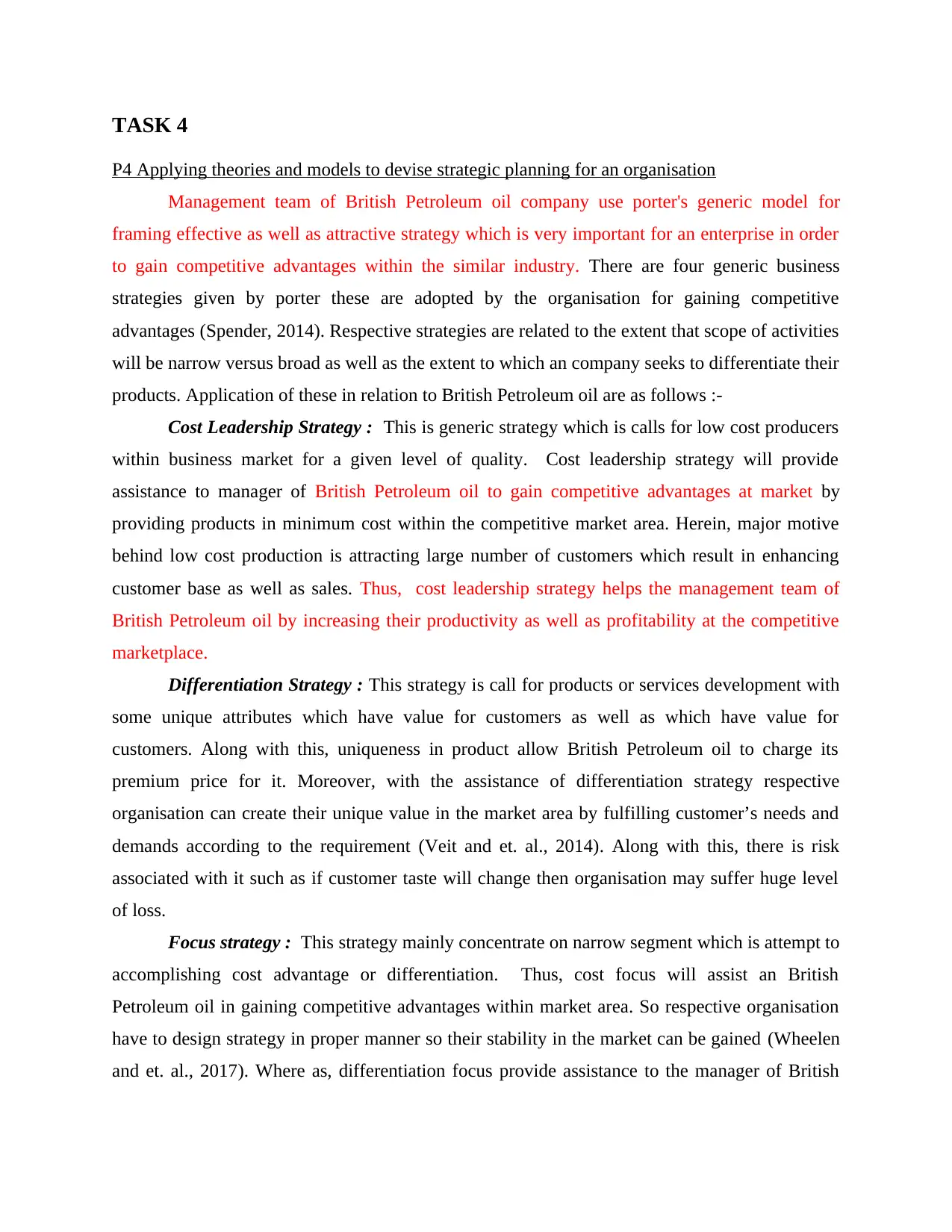
TASK 4
P4 Applying theories and models to devise strategic planning for an organisation
Management team of British Petroleum oil company use porter's generic model for
framing effective as well as attractive strategy which is very important for an enterprise in order
to gain competitive advantages within the similar industry. There are four generic business
strategies given by porter these are adopted by the organisation for gaining competitive
advantages (Spender, 2014). Respective strategies are related to the extent that scope of activities
will be narrow versus broad as well as the extent to which an company seeks to differentiate their
products. Application of these in relation to British Petroleum oil are as follows :-
Cost Leadership Strategy : This is generic strategy which is calls for low cost producers
within business market for a given level of quality. Cost leadership strategy will provide
assistance to manager of British Petroleum oil to gain competitive advantages at market by
providing products in minimum cost within the competitive market area. Herein, major motive
behind low cost production is attracting large number of customers which result in enhancing
customer base as well as sales. Thus, cost leadership strategy helps the management team of
British Petroleum oil by increasing their productivity as well as profitability at the competitive
marketplace.
Differentiation Strategy : This strategy is call for products or services development with
some unique attributes which have value for customers as well as which have value for
customers. Along with this, uniqueness in product allow British Petroleum oil to charge its
premium price for it. Moreover, with the assistance of differentiation strategy respective
organisation can create their unique value in the market area by fulfilling customer’s needs and
demands according to the requirement (Veit and et. al., 2014). Along with this, there is risk
associated with it such as if customer taste will change then organisation may suffer huge level
of loss.
Focus strategy : This strategy mainly concentrate on narrow segment which is attempt to
accomplishing cost advantage or differentiation. Thus, cost focus will assist an British
Petroleum oil in gaining competitive advantages within market area. So respective organisation
have to design strategy in proper manner so their stability in the market can be gained (Wheelen
and et. al., 2017). Where as, differentiation focus provide assistance to the manager of British
P4 Applying theories and models to devise strategic planning for an organisation
Management team of British Petroleum oil company use porter's generic model for
framing effective as well as attractive strategy which is very important for an enterprise in order
to gain competitive advantages within the similar industry. There are four generic business
strategies given by porter these are adopted by the organisation for gaining competitive
advantages (Spender, 2014). Respective strategies are related to the extent that scope of activities
will be narrow versus broad as well as the extent to which an company seeks to differentiate their
products. Application of these in relation to British Petroleum oil are as follows :-
Cost Leadership Strategy : This is generic strategy which is calls for low cost producers
within business market for a given level of quality. Cost leadership strategy will provide
assistance to manager of British Petroleum oil to gain competitive advantages at market by
providing products in minimum cost within the competitive market area. Herein, major motive
behind low cost production is attracting large number of customers which result in enhancing
customer base as well as sales. Thus, cost leadership strategy helps the management team of
British Petroleum oil by increasing their productivity as well as profitability at the competitive
marketplace.
Differentiation Strategy : This strategy is call for products or services development with
some unique attributes which have value for customers as well as which have value for
customers. Along with this, uniqueness in product allow British Petroleum oil to charge its
premium price for it. Moreover, with the assistance of differentiation strategy respective
organisation can create their unique value in the market area by fulfilling customer’s needs and
demands according to the requirement (Veit and et. al., 2014). Along with this, there is risk
associated with it such as if customer taste will change then organisation may suffer huge level
of loss.
Focus strategy : This strategy mainly concentrate on narrow segment which is attempt to
accomplishing cost advantage or differentiation. Thus, cost focus will assist an British
Petroleum oil in gaining competitive advantages within market area. So respective organisation
have to design strategy in proper manner so their stability in the market can be gained (Wheelen
and et. al., 2017). Where as, differentiation focus provide assistance to the manager of British
⊘ This is a preview!⊘
Do you want full access?
Subscribe today to unlock all pages.

Trusted by 1+ million students worldwide
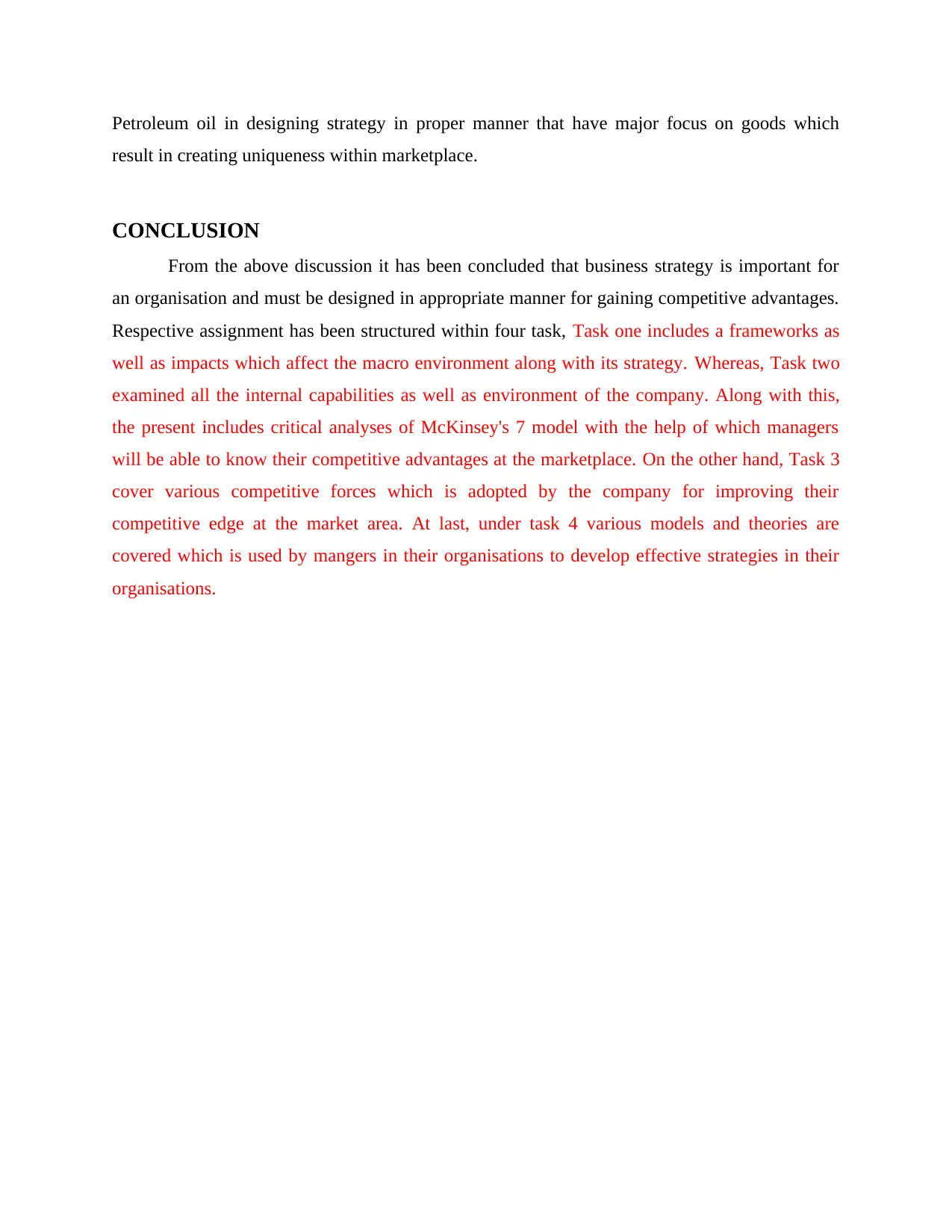
Petroleum oil in designing strategy in proper manner that have major focus on goods which
result in creating uniqueness within marketplace.
CONCLUSION
From the above discussion it has been concluded that business strategy is important for
an organisation and must be designed in appropriate manner for gaining competitive advantages.
Respective assignment has been structured within four task, Task one includes a frameworks as
well as impacts which affect the macro environment along with its strategy. Whereas, Task two
examined all the internal capabilities as well as environment of the company. Along with this,
the present includes critical analyses of McKinsey's 7 model with the help of which managers
will be able to know their competitive advantages at the marketplace. On the other hand, Task 3
cover various competitive forces which is adopted by the company for improving their
competitive edge at the market area. At last, under task 4 various models and theories are
covered which is used by mangers in their organisations to develop effective strategies in their
organisations.
result in creating uniqueness within marketplace.
CONCLUSION
From the above discussion it has been concluded that business strategy is important for
an organisation and must be designed in appropriate manner for gaining competitive advantages.
Respective assignment has been structured within four task, Task one includes a frameworks as
well as impacts which affect the macro environment along with its strategy. Whereas, Task two
examined all the internal capabilities as well as environment of the company. Along with this,
the present includes critical analyses of McKinsey's 7 model with the help of which managers
will be able to know their competitive advantages at the marketplace. On the other hand, Task 3
cover various competitive forces which is adopted by the company for improving their
competitive edge at the market area. At last, under task 4 various models and theories are
covered which is used by mangers in their organisations to develop effective strategies in their
organisations.
Paraphrase This Document
Need a fresh take? Get an instant paraphrase of this document with our AI Paraphraser
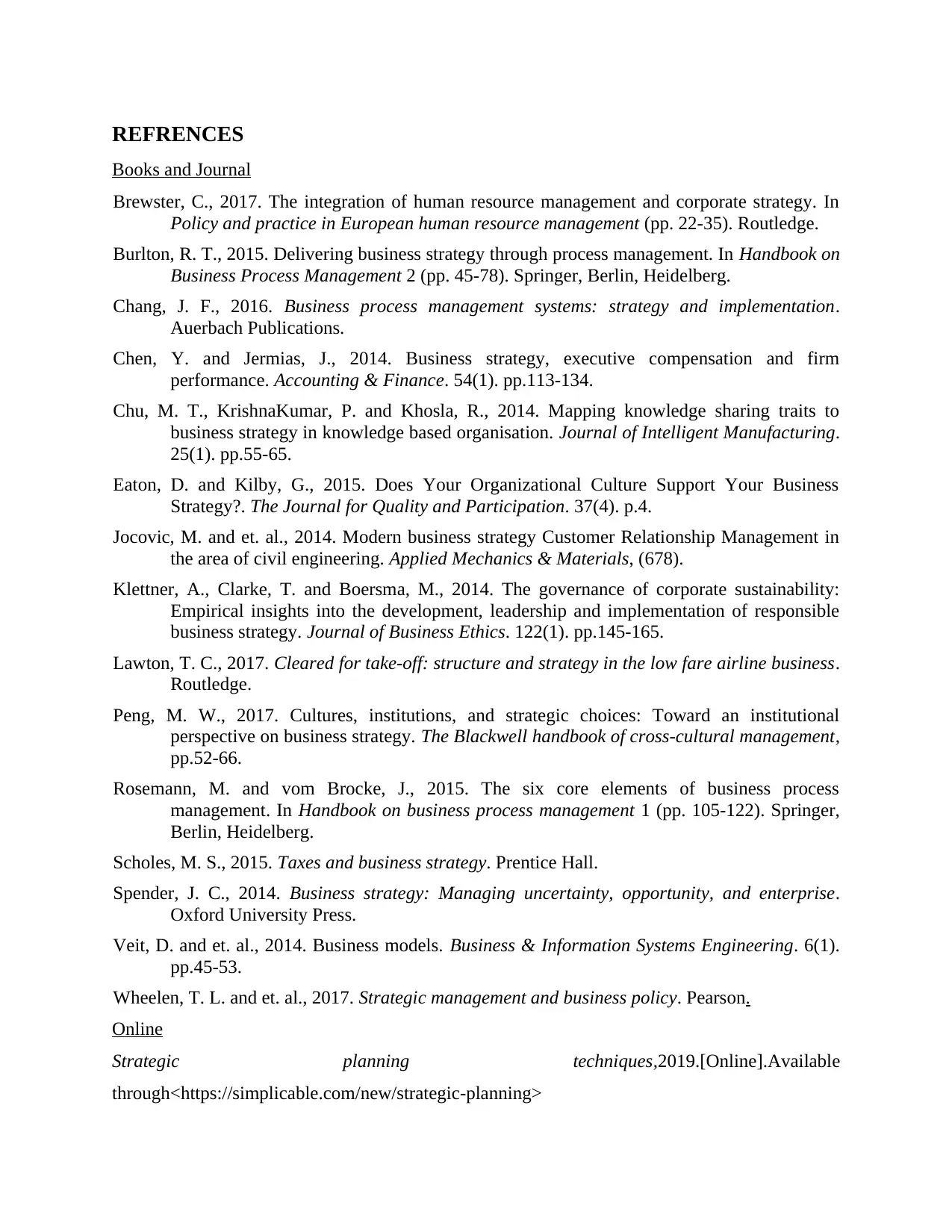
REFRENCES
Books and Journal
Brewster, C., 2017. The integration of human resource management and corporate strategy. In
Policy and practice in European human resource management (pp. 22-35). Routledge.
Burlton, R. T., 2015. Delivering business strategy through process management. In Handbook on
Business Process Management 2 (pp. 45-78). Springer, Berlin, Heidelberg.
Chang, J. F., 2016. Business process management systems: strategy and implementation.
Auerbach Publications.
Chen, Y. and Jermias, J., 2014. Business strategy, executive compensation and firm
performance. Accounting & Finance. 54(1). pp.113-134.
Chu, M. T., KrishnaKumar, P. and Khosla, R., 2014. Mapping knowledge sharing traits to
business strategy in knowledge based organisation. Journal of Intelligent Manufacturing.
25(1). pp.55-65.
Eaton, D. and Kilby, G., 2015. Does Your Organizational Culture Support Your Business
Strategy?. The Journal for Quality and Participation. 37(4). p.4.
Jocovic, M. and et. al., 2014. Modern business strategy Customer Relationship Management in
the area of civil engineering. Applied Mechanics & Materials, (678).
Klettner, A., Clarke, T. and Boersma, M., 2014. The governance of corporate sustainability:
Empirical insights into the development, leadership and implementation of responsible
business strategy. Journal of Business Ethics. 122(1). pp.145-165.
Lawton, T. C., 2017. Cleared for take-off: structure and strategy in the low fare airline business.
Routledge.
Peng, M. W., 2017. Cultures, institutions, and strategic choices: Toward an institutional
perspective on business strategy. The Blackwell handbook of cross‐cultural management,
pp.52-66.
Rosemann, M. and vom Brocke, J., 2015. The six core elements of business process
management. In Handbook on business process management 1 (pp. 105-122). Springer,
Berlin, Heidelberg.
Scholes, M. S., 2015. Taxes and business strategy. Prentice Hall.
Spender, J. C., 2014. Business strategy: Managing uncertainty, opportunity, and enterprise.
Oxford University Press.
Veit, D. and et. al., 2014. Business models. Business & Information Systems Engineering. 6(1).
pp.45-53.
Wheelen, T. L. and et. al., 2017. Strategic management and business policy. Pearson.
Online
Strategic planning techniques,2019.[Online].Available
through<https://simplicable.com/new/strategic-planning>
Books and Journal
Brewster, C., 2017. The integration of human resource management and corporate strategy. In
Policy and practice in European human resource management (pp. 22-35). Routledge.
Burlton, R. T., 2015. Delivering business strategy through process management. In Handbook on
Business Process Management 2 (pp. 45-78). Springer, Berlin, Heidelberg.
Chang, J. F., 2016. Business process management systems: strategy and implementation.
Auerbach Publications.
Chen, Y. and Jermias, J., 2014. Business strategy, executive compensation and firm
performance. Accounting & Finance. 54(1). pp.113-134.
Chu, M. T., KrishnaKumar, P. and Khosla, R., 2014. Mapping knowledge sharing traits to
business strategy in knowledge based organisation. Journal of Intelligent Manufacturing.
25(1). pp.55-65.
Eaton, D. and Kilby, G., 2015. Does Your Organizational Culture Support Your Business
Strategy?. The Journal for Quality and Participation. 37(4). p.4.
Jocovic, M. and et. al., 2014. Modern business strategy Customer Relationship Management in
the area of civil engineering. Applied Mechanics & Materials, (678).
Klettner, A., Clarke, T. and Boersma, M., 2014. The governance of corporate sustainability:
Empirical insights into the development, leadership and implementation of responsible
business strategy. Journal of Business Ethics. 122(1). pp.145-165.
Lawton, T. C., 2017. Cleared for take-off: structure and strategy in the low fare airline business.
Routledge.
Peng, M. W., 2017. Cultures, institutions, and strategic choices: Toward an institutional
perspective on business strategy. The Blackwell handbook of cross‐cultural management,
pp.52-66.
Rosemann, M. and vom Brocke, J., 2015. The six core elements of business process
management. In Handbook on business process management 1 (pp. 105-122). Springer,
Berlin, Heidelberg.
Scholes, M. S., 2015. Taxes and business strategy. Prentice Hall.
Spender, J. C., 2014. Business strategy: Managing uncertainty, opportunity, and enterprise.
Oxford University Press.
Veit, D. and et. al., 2014. Business models. Business & Information Systems Engineering. 6(1).
pp.45-53.
Wheelen, T. L. and et. al., 2017. Strategic management and business policy. Pearson.
Online
Strategic planning techniques,2019.[Online].Available
through<https://simplicable.com/new/strategic-planning>

⊘ This is a preview!⊘
Do you want full access?
Subscribe today to unlock all pages.

Trusted by 1+ million students worldwide
1 out of 12
Related Documents
Your All-in-One AI-Powered Toolkit for Academic Success.
+13062052269
info@desklib.com
Available 24*7 on WhatsApp / Email
![[object Object]](/_next/static/media/star-bottom.7253800d.svg)
Unlock your academic potential
Copyright © 2020–2025 A2Z Services. All Rights Reserved. Developed and managed by ZUCOL.





